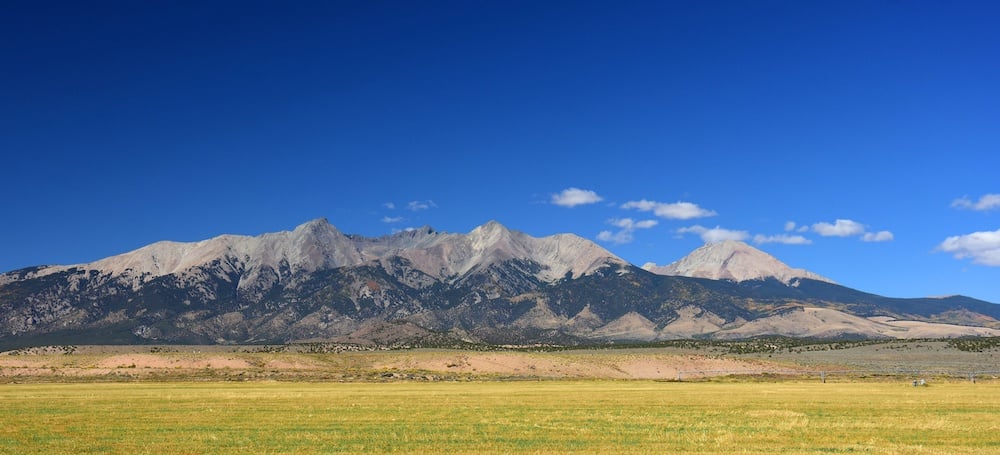As the sandhill cranes migrate to the San Luis Valley, nestled beneath the Sangre de Cristo mountains each year, so does Francesca Macaluso, MPH. Each spends their time in the valley among the wetlands and agricultural fields, tied deeply to the earth and the struggling aquifers below it.
From Atlanta, Georgia, with both parents working for the Centers for Disease Control and Prevention (CDC) throughout their careers, human and environmental health issues were always apart of Macaluso’s personal landscape. As a senior professional research assistant (SrPRA) and doctorate in public health (DrPH) candidate at the Colorado School of Public Health (ColoradoSPH), Macaluso explores the relationships between issues such as drought and heavy metals exposure in her research projects in the San Luis Valley of Southern Colorado.
Mentorship in Colorado
Macaluso had visited Colorado as a teenager and told her parents on the spot that someday she would live there. After earning her Master’s in Public Health from Emory University, she applied to work with Katherine James, PhD, MSPH, MSCE, associate professor in the Department of Environmental and Occupational Health at the ColoradoSPH.
"Working in the SLV, its abundantly clear how
both physical and social landscapes impact
how we do environmental health research."
The scenery and the academic experience may have drawn Macaluso to Colorado, but the mentorship has kept her. “The culture here is different,” said Macaluso. “Our faculty truly like students and really enjoy mentoring them. It sounds silly, but that is not a given. No matter what stage you are in your training, there are a lot of opportunities for projects where you have real ownership over what you do!”
Under James’ mentorship, Macaluso works on research projects in the San Luis Valley, a region of the state rich in agriculture history and plagued by drought and increasingly higher risk to heavy metal exposures. Each of their projects incorporates water quality, metals exposure, and of rising importance, climate and weather factors.
A pressing health concern
“The San Luis Valley is a mineral rich region both from its natural geology and as a result of the mining and agricultural activities,” said Macaluso. “Metals exposure continues to be a pressing health concern for those communities.”
Macaluso is investigating the impacts of these factors on kidney health and diabetes as well as maternal and early childhood health. Along with James and their team, Macaluso is also connecting each of these studies to the severe drought in the region. The team is examining how extended periods of drought affect the concentration of these metals in groundwater for communities that rely heavily on well water.
These environmental impacts pose risks for the psychological, social and cultural well-being of the region as well. Another one of the group’s projects explores how drought and the subsequent impacts on crop-yield and financial well-being affect mental health in agricultural workers. They hope this research will open new avenues for improving access to mental health care in the population.

Community outreach, a key piece
As they deepen their understanding of how these pieces affect the lives of communities in the state, Macaluso focuses on application.
“We have a solid scientific evidence base that exposure to heavy metals will go up after periods of drought, and likely impact people’s health,” said Macaluso. “I wonder how we can leverage our existing well-monitoring programs and communication channels within the state health department to get this information out there. Ideally, our findings become a tool to help people make informed choices about what they use well water for throughout the year. This is just one piece of the puzzle in improving long term access to clean water in the region.”
A possible answer to Macaluso’s wonderings is a key part of her research. Community outreach and partnerships are essential to the research and the solution. As part of James’ lab, Macaluso has worked with several San Luis Valley environmental and water conservation and community action groups. Through equitable partnerships, their studies have incorporated community concerns in real-time, as well as provided technical assistance to support community organizations in achieving their own goals.
Macaluso and James are keenly aware of the often imbalanced relationships between researchers and study participants. They prioritize not solely asking for help with their research, but they try to organize projects that help community-based organizations in return. As part of an ongoing study, they recently assisted a non-profit in compiling 50+ years of water, soil, and other environmental monitoring data into an online, user-friendly, publicly accessible database.
“The San Luis Valley is a beautiful place filled with some of the most spectacular mountain ranges in Colorado and home to Great Sand Dunes National Park. Working there, its abundantly clear how both physical and social landscapes impact how we do environmental health research. Without the expertise and support of our community partners, we wouldn’t be able to do much more than scratch the surface of a place like this,” said Macaluso.
While this approach to public health practice is no secret, the knowing does not make it any easier to conduct. Good public health practice and research are not independent things. This is the solution that drives Macaluso’s work. In her own words, to do any of them effectively, they must all be done together.




%20(2).png)

